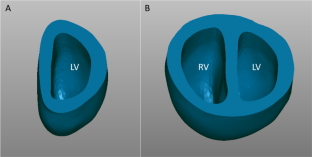Biomechanics and Modeling in Mechanobiology ( IF 3.5 ) Pub Date : 2024-04-08 , DOI: 10.1007/s10237-024-01842-6 Meifeng Ren , Wei Xuan Chan , Laura Green , Martin L. Buist , Choon Hwai Yap

|
Finite Element simulations are a robust way of investigating cardiac biomechanics. To date, it has only been performed with the left ventricle (LV) alone for fetal hearts, even though results are likely different with biventricular (BiV) simulations. In this research, we conduct BiV simulations of the fetal heart based on 4D echocardiography images to show that it can capture the biomechanics of the normal healthy fetal heart, as well as those of fetal aortic stenosis better than the LV alone simulations. We found that performing LV alone simulations resulted in overestimation of LV stresses and pressures, compared to BiV simulations. Interestingly, inserting a compliance between the LV and right ventricle (RV) in the lumped parameter model of the LV only simulation effectively resolved these overestimations, demonstrating that the septum could be considered to play a LV-RV pressure communication role. However, stresses and strains spatial patterns remained altered from BiV simulations after the addition of the compliance. The BiV simulations corroborated previous studies in showing disease effects on the LV, where fetal aortic stenosis (AS) drastically elevated LV pressures and reduced strains and stroke volumes, which were moderated down with the addition of mitral regurgitation (MR). However, BiV simulations enabled an evaluation of the RV as well, where we observed that effects of the AS and MR on pressures and stroke volumes were generally much smaller and less consistent. The BiV simulations also enabled investigations of septal dynamics, which showed a rightward shift with AS, and partial restoration with MR. Interestingly, AS tended to enhance RV stroke volume, but MR moderated that down.
中文翻译:

健康胎儿心脏和严重主动脉瓣狭窄期间的双心室有限元建模
有限元模拟是研究心脏生物力学的有效方法。迄今为止,仅对胎儿心脏进行了左心室 (LV) 模拟,尽管结果可能与双心室 (BiV) 模拟不同。在这项研究中,我们基于 4D 超声心动图图像对胎儿心脏进行 BiV 模拟,结果表明,与单独的左心室模拟相比,它可以更好地捕获正常健康胎儿心脏以及胎儿主动脉瓣狭窄的生物力学。我们发现,与 BiV 模拟相比,单独进行 LV 模拟会导致 LV 应力和压力的高估。有趣的是,在仅模拟 LV 的集总参数模型中插入 LV 和右心室 (RV) 之间的顺应性有效解决了这些高估问题,表明隔膜可以被认为发挥 LV-RV 压力沟通作用。然而,在添加柔量后,应力和应变空间模式仍然与 BiV 模拟发生变化。 BiV 模拟证实了先前的研究,显示疾病对左心室的影响,其中胎儿主动脉瓣狭窄 (AS) 急剧升高左心室压力,并减少应变和每搏输出量,而二尖瓣反流 (MR) 的增加可以减轻这种影响。然而,BiV 模拟也可以对 RV 进行评估,我们观察到 AS 和 MR 对压力和每搏输出量的影响通常要小得多且不太一致。 BiV 模拟还能够研究隔膜动力学,显示 AS 向右移动,MR 部分恢复。有趣的是,AS 往往会增加 RV 的每搏输出量,但 MR 会降低这一效果。



























 京公网安备 11010802027423号
京公网安备 11010802027423号